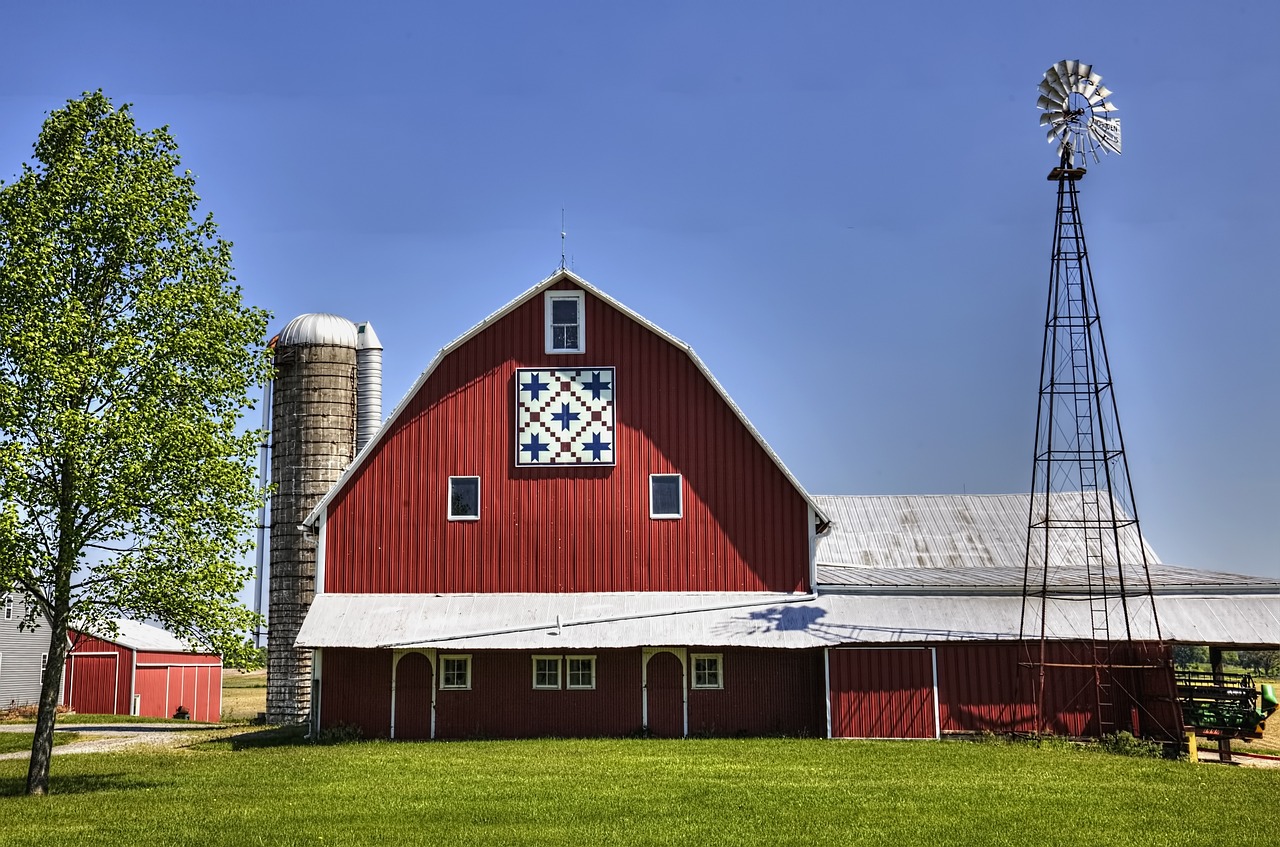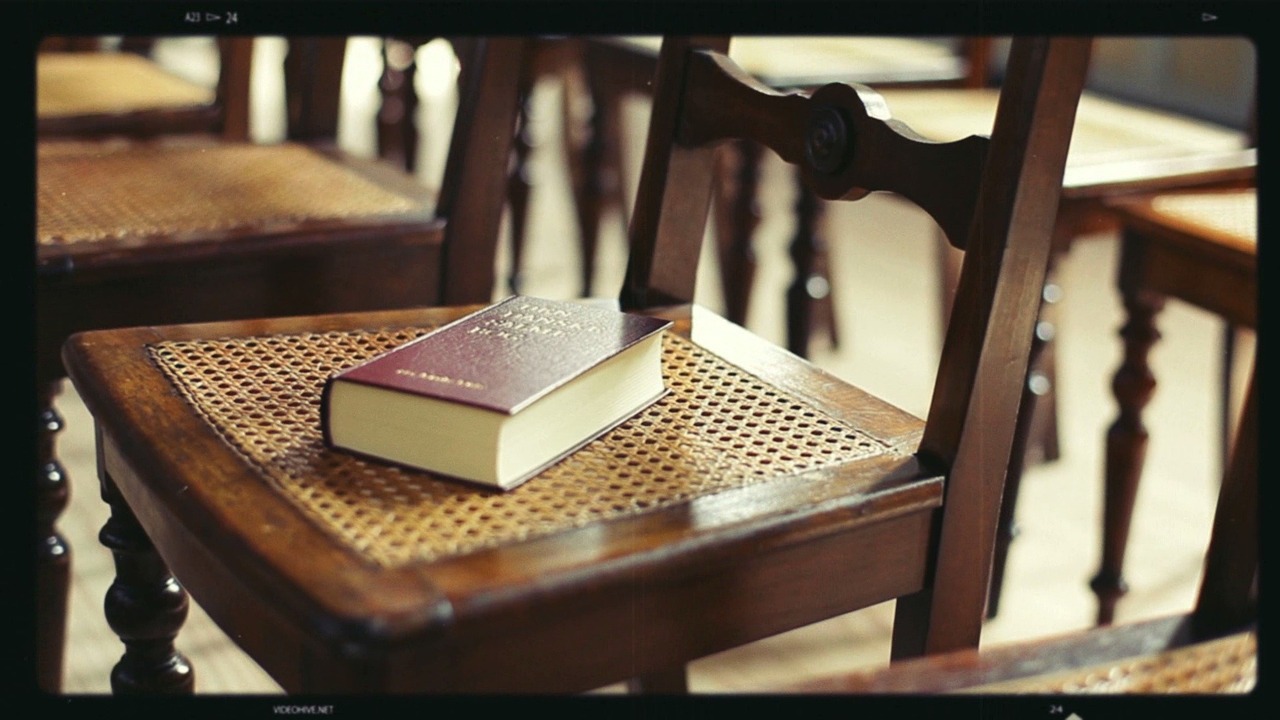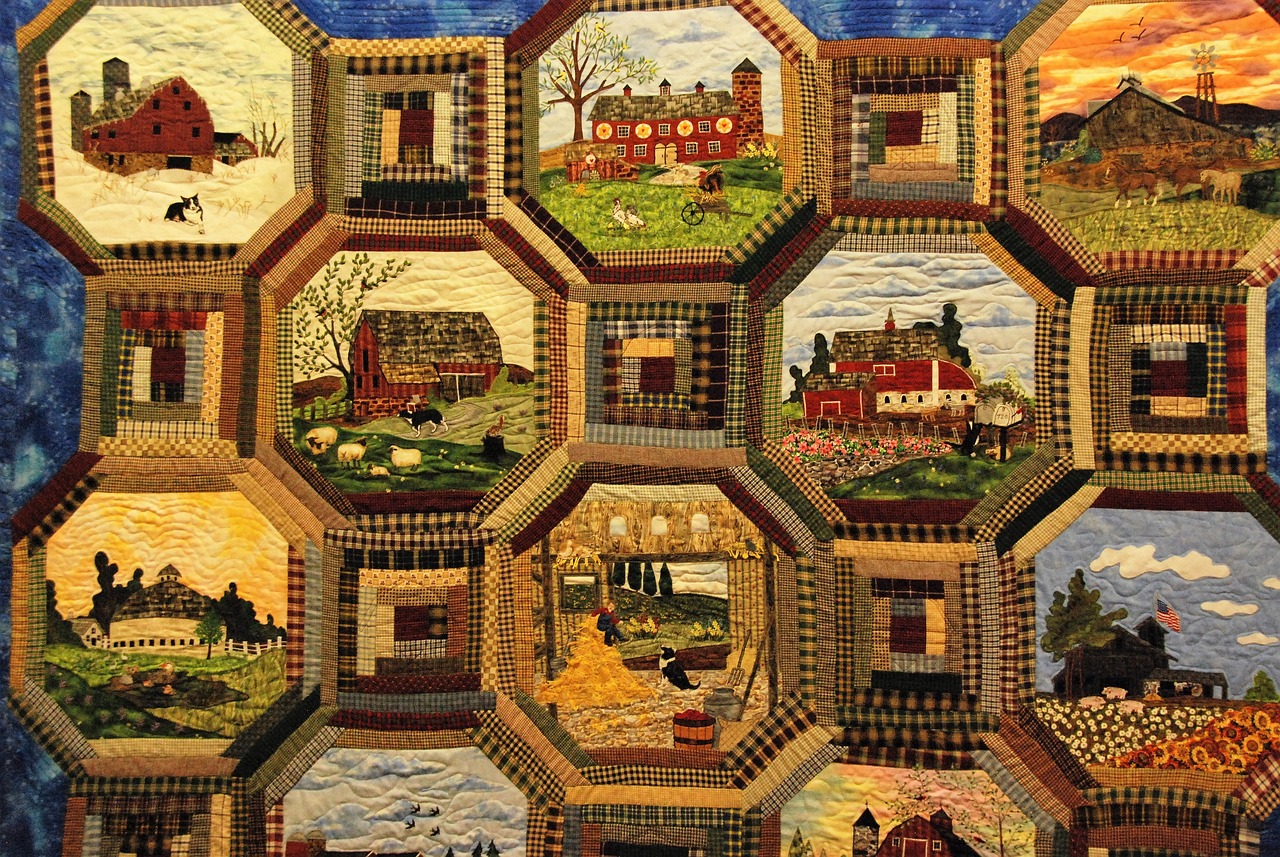Finding Inspiration for Your Next Quilting Project
Are you feeling a creative block when it comes to your quilting projects? Don't worry; you're not alone! Every quilter, whether a seasoned pro or a newbie, can find themselves searching for that elusive spark of inspiration. The good news is that inspiration is all around us, waiting to be discovered! From the vibrant colors of nature to the rich tapestry of art and culture, there are countless sources to ignite your creativity. In this article, we’ll explore various avenues that can help you find fresh ideas for your next quilting venture.
Nature is a treasure trove of inspiration, offering a stunning palette of colors and patterns that can transform your quilting designs. Imagine walking through a lush forest, where the greens of the leaves blend with the earthy browns of the bark and the vibrant pops of wildflowers. You can translate these beautiful scenes into fabric art by selecting fabrics that reflect these natural hues. For example, consider using a soft green fabric that mimics the lushness of moss, paired with bright yellow and purple prints that echo the wildflowers. The key is to let the beauty of the outdoors inspire your color choices and patterns.
Art movements and cultural elements can also provide a fresh perspective on your quilting patterns. Think about how famous artworks, like Van Gogh's "Starry Night" or Monet's water lilies, can inspire your designs. You might choose to replicate the swirling patterns of the night sky or the soft, impressionistic colors of a garden. Additionally, exploring traditional crafts from around the world can introduce you to unique techniques and styles. For instance, you might incorporate elements from Japanese sashiko stitching or Native American quilt patterns, blending them into your own creations for a truly global quilt.
Engaging with quilting communities can be a game-changer for your creative process. Whether you join a local quilting group or participate in online forums, sharing ideas and techniques with fellow quilters can ignite new inspiration. Imagine sitting in a circle with other quilters, exchanging stories and tips, and suddenly finding yourself motivated to try a new pattern or technique you've never considered before. The camaraderie and support of these communities can help you break through creative barriers and explore new avenues in your quilting journey.
Your personal experiences and family histories can add depth and meaning to your quilting projects. Think about the stories that have shaped your life—perhaps a beloved grandmother taught you to sew, or a family vacation inspired a particular color palette. By weaving your narrative into your designs, you create a quilt that is not just a piece of art but a cherished memory. For instance, you could use fabrics that represent different places you've visited or colors that remind you of special moments with loved ones. This personal touch can make your quilt truly one-of-a-kind.
Seasonal changes offer a wealth of inspiration for quilting projects. Each season brings its own colors and motifs, from the vibrant blooms of spring to the warm hues of autumn. Consider creating quilts that reflect the essence of each season. For example, in spring, you might use pastel colors and floral patterns, while in winter, you could opt for deep blues and whites reminiscent of snow. By incorporating seasonal elements into your quilts, you not only celebrate nature's beauty but also create pieces that resonate with the time of year.
The variety of fabrics available can greatly influence your design direction. Different textures, patterns, and colors can inspire innovative quilting ideas. For example, mixing cotton with silk or linen can create a unique tactile experience, while combining bold prints with subtle solids can add visual interest. Don't be afraid to experiment with unexpected fabric combinations! A trip to your local fabric store can feel like a treasure hunt, where each bolt of fabric holds the potential for a new project. Keep an open mind and let your fabric choices guide your creative process.
Studying historical quilts can provide valuable insights into traditional patterns and techniques. These quilts often tell stories of the past, reflecting the cultural heritage and craftsmanship of their time. By examining these timeless designs, you can adapt them into your modern quilting projects. For instance, you might take a classic log cabin pattern and reinterpret it with contemporary fabrics and colors. This blend of old and new can create quilts that honor tradition while also showcasing your unique style.
Traveling exposes you to new cultures and aesthetics, offering a rich source of inspiration for your quilting projects. Reflect on the colors, patterns, and textures you encountered on your journeys. Perhaps the vibrant markets of Marrakech or the serene landscapes of the English countryside left a lasting impression on you. You can capture the essence of these experiences in your quilts by selecting fabrics that echo the colors and motifs of the places you've visited. Your quilts can become a visual diary of your travels, telling stories of the adventures you've had.
Participating in workshops and classes can enhance your skills and inspire new ideas. These hands-on learning experiences often introduce you to new techniques and approaches that can elevate your quilting creativity. Imagine spending a weekend immersed in a quilting workshop, surrounded by fellow enthusiasts, and learning from an expert instructor. You'll not only gain valuable skills but also leave with a fresh perspective and a head full of new ideas. So, why not seek out a local quilting class or an online workshop? You might just find the inspiration you've been looking for!
- What are some good sources of inspiration for quilting? Nature, art, culture, personal stories, and travel experiences can all provide great inspiration.
- How can I incorporate my personal story into my quilts? Use fabrics and colors that represent significant moments or memories in your life.
- Are there benefits to joining a quilting community? Yes! Engaging with others can spark new ideas and techniques, making your quilting journey more enjoyable.

Exploring Nature
When we think about inspiration, nature is often the first place our minds wander. Imagine stepping outside and being greeted by a vibrant tapestry of colors, textures, and patterns that shift with the seasons. From the delicate petals of a blooming flower to the rugged bark of an ancient tree, nature provides a rich palette for any quilting enthusiast. Have you ever taken a moment to truly observe the intricate details in your surroundings? Perhaps the way sunlight dances on leaves or the soft hues of a sunset could translate beautifully into your next quilt design.
One of the most exciting aspects of drawing inspiration from nature is the ability to capture its essence in fabric. Think about the colors you see around you. For instance, the deep greens of a forest can inspire a lush quilt, while the bright yellows and oranges of autumn leaves might lead to a warm and inviting piece. You could even create a quilt that mimics the patterns of a butterfly’s wings or the swirling shapes of clouds in the sky. The possibilities are endless!
To help you get started on translating nature into your quilting projects, consider the following tips:
- Take Photos: Carry a camera or your smartphone on your nature walks. Snap pictures of interesting textures, colors, and patterns that catch your eye.
- Create a Nature Journal: Document your observations in a journal. Sketch the shapes of leaves, note the colors of flowers, or describe the feeling of a gentle breeze.
- Use Natural Dyes: Experiment with natural dyes made from plants, fruits, and vegetables to create unique fabric colors that reflect the environment.
By incorporating these elements into your quilting practice, you’re not just creating a quilt; you’re telling a story that reflects the world around you. Each stitch can represent a moment spent in nature, a memory of a beautiful hike, or even a serene afternoon in your garden. Imagine wrapping yourself in a quilt that not only keeps you warm but also connects you to the beauty of the great outdoors.
Moreover, consider how seasonal changes can influence your quilting. In spring, vibrant pastels might inspire a light and airy quilt, while summer could lead you to bold, bright colors that reflect the sun's energy. Autumn brings earthy tones, and winter can inspire cool blues and whites. By aligning your quilting with the seasons, you create pieces that resonate with the time of year and evoke specific feelings.
In summary, exploring nature as a source of inspiration for your quilting projects can transform your work into something truly special. It allows you to connect with the world around you and express that connection through your art. So, the next time you find yourself stuck for ideas, step outside and let the beauty of nature ignite your creativity!

Art and Culture
Art and culture are treasure troves of inspiration for quilting enthusiasts. Imagine walking through a vibrant gallery filled with bold colors and intricate patterns. Each piece tells a story, and as a quilter, you can harness that creativity to craft your own narrative through fabric. Whether it's the swirling brush strokes of a Van Gogh painting or the delicate motifs of traditional Japanese textiles, there’s a world of ideas waiting for you.
One of the most exciting aspects of drawing inspiration from art is the endless variety of styles available. For instance, consider impressionism with its soft edges and pastel hues, or abstract art that plays with shapes and colors in unexpected ways. You can translate these elements into your quilting by using similar color palettes or creating geometric patterns that mimic the artwork. The key is to let your imagination run wild! Why not try to replicate the feel of a famous painting in your next quilt? It’s like bringing a piece of art into your home, but with your personal twist.
Moreover, cultural elements provide a rich canvas for inspiration. Different cultures have unique quilting traditions that can spark your creativity. For example, the vibrant colors and geometric shapes found in African textiles can inspire a quilt bursting with life and energy. Similarly, Native American quilts often feature rich symbolism and storytelling, which can add depth to your designs. By studying these traditions, you can learn new techniques and incorporate them into your own work, creating a quilt that honors the past while being distinctly yours.
To get started, consider visiting local museums or galleries that showcase textile art. Take a sketchbook with you to jot down ideas or even take photos of pieces that resonate with you. You might find yourself inspired by a simple detail, like the way light reflects off a fabric or the rhythm of a repeating pattern. Engaging with art in this way can open your eyes to new possibilities and push your quilting to new heights.
Additionally, exploring art movements can also provide a structured path to inspiration. Here’s a quick overview of some movements that can influence your quilting:
| Art Movement | Characteristics | Quilting Inspiration |
|---|---|---|
| Impressionism | Soft colors, light effects | Use pastels and blending techniques |
| Abstract | Non-representational forms | Experiment with geometric shapes |
| Folk Art | Traditional motifs, vibrant colors | Incorporate cultural symbols and stories |
| Modernism | Simplicity, minimalism | Focus on clean lines and bold colors |
In conclusion, art and culture are not just sources of inspiration; they are gateways to a deeper understanding of the world around us. By immersing yourself in various artistic expressions, you can transform your quilting projects into meaningful works of art that resonate with your personal experiences and the stories you wish to tell. So, the next time you find yourself in a creative rut, remember to look beyond the fabric and into the rich tapestry of art and culture that surrounds us!
- How can I find art that inspires my quilting? Visit local galleries, museums, or explore online art collections to discover pieces that resonate with you.
- Can I incorporate cultural elements into my quilting? Absolutely! Research different cultures' textile traditions and find ways to respectfully integrate those elements into your designs.
- What are some modern art movements I can draw inspiration from? Consider looking into movements like abstract art, minimalism, or even pop art for fresh ideas.

Quilting Communities
Engaging with can be a game-changer for any quilting enthusiast, whether you're a seasoned pro or just starting out. These communities are like vibrant threads woven together, creating a rich tapestry of ideas, techniques, and inspiration. Imagine walking into a room filled with fellow quilters, each one bringing their unique style and perspective to the table. The energy is palpable, and suddenly, your own creative juices start flowing! But how exactly can these communities ignite your passion for quilting?
First and foremost, quilting communities provide a platform for sharing knowledge. Whether it's through local guilds, online forums, or social media groups, you can tap into a wealth of experience. Have you ever struggled with a particular technique? Perhaps you’re unsure about color choices or fabric combinations? In these communities, you can ask questions and receive advice from those who have been in your shoes. It's like having a personal mentor at your fingertips!
Moreover, being part of a quilting community fosters a sense of belonging. Quilting can sometimes feel like a solitary hobby, but joining a group can transform that experience. You’ll find camaraderie and support, which can be incredibly motivating. Many quilters find that they create their best work when they are surrounded by others who share their passion. You might even find a quilting buddy to collaborate with or bounce ideas off of!
Additionally, quilting communities often host events such as workshops, retreats, and quilt shows. These gatherings are fantastic opportunities to learn new techniques, discover fresh ideas, and showcase your work. Imagine spending a weekend immersed in quilting, surrounded by beautiful fabrics, inspiring designs, and the laughter of fellow quilters. It’s a feast for the senses and a chance to recharge your creative batteries!
For those who prefer digital interactions, online platforms have revolutionized how quilters connect. Websites and social media groups allow you to share your projects, seek feedback, and even participate in virtual challenges. You can join online quilt-alongs, where everyone works on the same project simultaneously, sharing progress and tips along the way. The world of quilting is at your fingertips, and you can connect with quilters from all over the globe!
In summary, engaging with quilting communities can profoundly enrich your quilting journey. From sharing knowledge and gaining support to participating in exciting events, the benefits are endless. So why not take the plunge? Find a local group or an online forum that resonates with you, and start connecting with others who share your passion for quilting. You never know what kind of inspiration awaits you!
- How can I find a local quilting group? Check local craft stores, community centers, or online platforms like Meetup to find quilting groups near you.
- What are the benefits of joining an online quilting community? Online communities offer flexibility, access to a wider range of quilters, and the ability to share and receive feedback quickly.
- Can I participate in quilting communities if I'm a beginner? Absolutely! Many quilting communities welcome beginners and offer resources and support to help you grow.

Personal Stories
When it comes to quilting, can serve as a powerful source of inspiration. Each quilt you create can be a tapestry of your life experiences, woven together with threads of memory, emotion, and creativity. Have you ever thought about how a simple fabric choice could represent a cherished moment or a loved one? By infusing your quilts with personal narratives, you not only make them more meaningful but also create a unique piece of art that reflects your journey.
Consider the story behind your fabric. Perhaps the vibrant floral print reminds you of your grandmother's garden, where you spent countless summer afternoons picking daisies. Or maybe a rustic plaid evokes memories of family gatherings in a cozy cabin. These connections can guide your design choices, allowing you to create a quilt that resonates deeply with your heart and soul.
Moreover, sharing your personal stories with fellow quilters can foster a sense of community and connection. When you open up about your inspirations, you invite others to share theirs. This exchange can lead to collaborative projects, where each member contributes a piece of their narrative, resulting in a quilt that tells a collective story. Imagine the beauty of a quilt made from squares that each represent a different life experience, stitched together to form a beautiful whole.
To illustrate this concept, let’s consider a few ways to incorporate personal stories into your quilting projects:
- Family Heritage: Use fabrics that represent your family's cultural background. Traditional patterns or colors can be woven into your quilt, paying homage to your ancestry.
- Milestones: Create a quilt that celebrates significant life events such as weddings, births, or graduations. Each patch can represent a different milestone, creating a visual timeline of your life.
- Travel Memories: If you've traveled to unique places, consider using fabrics that reflect the colors and patterns of those locations. This can turn your quilt into a travelogue of sorts, capturing the essence of your adventures.
Incorporating personal stories into your quilting not only enhances the creative process but also gives you a chance to reflect on your life. Each stitch becomes a reminder of where you've been and the moments that have shaped you. So, the next time you sit down to quilt, take a moment to think about the stories you want to tell. Your quilts can be more than just beautiful pieces of fabric; they can be living chronicles of your life, stitched together with love and intention.
Q: How can I start incorporating my personal stories into my quilting?
A: Begin by reflecting on significant moments in your life. Consider using fabrics that evoke those memories or represent your experiences. You can also write down your stories and keep them with your quilt as a personal keepsake.
Q: Can I share my personal stories with others while quilting?
A: Absolutely! Sharing your stories can create a deeper connection with fellow quilters. You can join quilting groups, either online or in-person, where you can exchange ideas and experiences.
Q: What if I don’t have any specific stories to tell?
A: That's okay! Sometimes inspiration comes from the smallest things. Look around you—nature, art, or even a favorite book can spark ideas. You can also create quilts that represent your hopes and dreams.

Seasonal Themes
When it comes to finding inspiration for your next quilting project, the changing seasons can be a treasure trove of ideas. Each season brings its own unique colors, textures, and motifs that can breathe life into your fabric creations. Imagine the vibrant reds and oranges of autumn leaves or the soft pastels of spring blooms; these natural palettes can guide your fabric choices and design elements. Seasonal themes not only reflect the beauty of nature but also evoke emotions and memories associated with different times of the year.
For instance, in spring, you might find inspiration in the delicate petals of cherry blossoms or the bright greens of newly sprouted grass. Fabrics with floral prints or light, airy colors can help capture the essence of this season. Consider using a combination of soft pinks, yellows, and greens to create a quilt that feels fresh and rejuvenating, much like the season itself.
As summer rolls in, the world transforms into a vibrant playground of color. Think of the deep blues of the ocean, the bright yellows of the sun, and the rich greens of lush gardens. You can incorporate these hues into your quilting by using bold, graphic prints that mimic the energy of summer. Fabrics that feature sunflowers, beach scenes, or tropical motifs can add a fun, lively touch to your quilts. This season is perfect for experimenting with bright colors and playful patterns that reflect the carefree spirit of summer.
As the leaves begin to change in autumn, your quilting designs can shift to reflect the warm, earthy tones of the season. Rich browns, burnt oranges, and deep reds can create a cozy feel, reminiscent of warm evenings spent by the fire. You might choose fabrics that feature pumpkins, acorns, or even a patchwork of autumn leaves. This is a great time to experiment with traditional quilting techniques, such as appliqué or patchwork, to create designs that tell a story of harvest and gratitude.
Finally, winter offers a completely different palette, often dominated by cool blues, whites, and silvers. Think about the serene beauty of a snowy landscape or the warmth of holiday celebrations. Fabrics with snowflakes, stars, or holiday motifs can inspire quilts that bring a sense of comfort and joy during the colder months. You might even consider incorporating textures like flannel or fleece to create a cozy quilt that invites snuggling on chilly nights.
To help you visualize how seasonal themes can be integrated into your quilting projects, here’s a quick reference table:
| Season | Color Palette | Motifs |
|---|---|---|
| Spring | Pastels (soft pinks, yellows, greens) | Flowers, leaves, butterflies |
| Summer | Bright colors (deep blues, yellows, greens) | Sunflowers, beach scenes, tropical prints |
| Autumn | Warm tones (browns, oranges, reds) | Pumpkins, acorns, autumn leaves |
| Winter | Cool tones (blues, whites, silvers) | Snowflakes, stars, holiday themes |
Incorporating seasonal themes into your quilting projects not only enhances the aesthetic appeal but also connects your creations to the world around you. So the next time you're looking for inspiration, step outside, take a deep breath, and let the beauty of the seasons guide your quilting journey!
Q: How can I choose fabrics that reflect seasonal themes?
A: Look for fabric collections that feature colors and patterns inspired by the season. For example, floral prints for spring or warm, earthy tones for autumn.
Q: Can I mix seasonal themes in one quilt?
A: Absolutely! Mixing seasonal elements can create a unique and personal touch. Just ensure that the colors and motifs complement each other harmoniously.
Q: What techniques work best for seasonal quilting?
A: Techniques like appliqué, patchwork, and even embroidery can effectively showcase seasonal motifs and create stunning visual effects in your quilts.

Fabric Choices
When it comes to quilting, the you make can significantly influence the overall look and feel of your project. Imagine walking into a fabric store and being greeted by a vibrant sea of colors and textures. It's like stepping into a candy shop, where each fabric is a unique treat waiting to be savored. The right fabric can transform a simple quilt into a stunning masterpiece that tells a story and evokes emotions.
One of the first things to consider is the texture of the fabric. Different textures can create various effects in your quilt. For instance, a soft flannel can give your quilt a cozy, warm feeling, perfect for snuggling up on a chilly evening. On the other hand, crisp cotton can provide a clean, fresh look, making it ideal for modern designs. Mixing textures can also add depth and interest to your quilting project, creating a tactile experience that invites touch.
Next up is the color palette. Choosing the right colors can be a daunting task, but it’s essential for setting the mood of your quilt. You might want to go for a calming palette of blues and greens reminiscent of a serene landscape, or perhaps vibrant reds and yellows that evoke the warmth of a sunny day. Consider using a color wheel to help you select complementary colors that enhance each other. A well-thought-out color scheme can elevate your quilt from ordinary to extraordinary.
Patterns also play a crucial role in your fabric choices. From bold florals to delicate paisleys, the patterns you select can convey different themes and styles. Some quilters prefer to use a mix of patterned fabrics to create a lively, eclectic look, while others may opt for solid fabrics to provide a more minimalist aesthetic. Don’t be afraid to experiment! Sometimes, the most unexpected combinations can yield stunning results.
Additionally, consider the weight of the fabric. Heavier fabrics like denim or canvas can be excellent for quilts that will be used outdoors or for projects that require durability. Conversely, lighter fabrics such as voile or batik are perfect for delicate, flowing designs. The weight of the fabric will also affect how your quilt drapes and hangs, so keep this in mind as you make your selections.
Lastly, don't forget about the source of your fabric. Supporting local fabric shops or sustainable fabric brands not only contributes to your community but also ensures that you are using high-quality materials. Many quilt shops offer unique, locally sourced fabrics that can add a personal touch to your projects. Remember, the journey of selecting fabric is just as important as the quilting process itself.
In summary, your fabric choices are the foundation of your quilting project. By considering texture, color, patterns, weight, and sourcing, you can create a quilt that is not only visually stunning but also rich in meaning and personal connection. So next time you embark on a quilting adventure, take a moment to appreciate the beautiful fabrics available to you, and let your creativity flow!
- What are the best fabrics for beginners? Cotton is often recommended for beginners due to its ease of handling and wide variety of colors and patterns.
- Can I mix different fabric types in one quilt? Yes! Mixing fabrics can add depth and interest, but be mindful of the weight and texture differences.
- How do I choose a color palette for my quilt? Consider using a color wheel and start with a few colors that complement each other. Don’t be afraid to experiment!
- Where can I find unique fabrics? Local quilt shops, craft fairs, and online fabric stores often have unique selections that can inspire your next project.

Historical Quilts
When we think about quilting, it’s easy to focus on the modern techniques and vibrant fabrics available today. However, diving into the world of can provide a treasure trove of inspiration and insight into the art form we cherish. These quilts are more than just blankets; they are a reflection of the times, cultures, and stories of the people who made them. Each stitch tells a tale, and every pattern holds a piece of history that can enrich your own quilting journey.
Take a moment to consider the intricate designs of the 19th century quilts, for instance. Many of these quilts were made during a time of great social change, and the patterns often represented the values and beliefs of the makers. Log Cabin and Nine Patch were popular patterns that not only showcased the skill of the quilter but also served as a means of communication. The Log Cabin pattern, with its symbolism of home and hearth, evokes a sense of warmth and comfort, while the Nine Patch reflects the idea of community and togetherness.
But how can we incorporate these historical elements into our own quilting projects? Here are a few ideas:
- Research Historical Patterns: Explore books or online resources that delve into historical quilting patterns. Understanding the stories behind these designs can help you appreciate their significance and inspire your own creations.
- Adapt Techniques: Many historical quilts used techniques that have fallen out of fashion. By learning and adapting these methods, you can add a unique twist to your quilts.
- Use Vintage Fabrics: Incorporating vintage fabrics into your quilts can give them a sense of history. Look for fabrics that echo the colors and patterns of the past.
Another fascinating aspect of historical quilts is their role in storytelling. Many quilts were created to commemorate significant events or to tell the stories of families. For example, the Crazy Quilt, which emerged in the late 19th century, often featured an assortment of fabrics, each piece representing a memory or a moment in time. By using this technique, you can create a quilt that tells your own story, weaving together memories and experiences through fabric.
Moreover, studying historical quilts can also provide insights into the social and economic contexts of their creation. For instance, during the Great Depression, many quilters used scraps and repurposed materials to create beautiful quilts, showcasing resilience and creativity. This can inspire you to think outside the box and use materials in innovative ways, making your quilting practice more sustainable and resourceful.
In essence, the world of historical quilts is a rich tapestry of inspiration waiting to be explored. By connecting with the past, you not only enhance your skills but also create pieces that resonate with deeper meaning and significance. So, the next time you sit down to quilt, consider looking back in time. You might just find the spark of creativity you need to ignite your next project!
Q: How can I find historical quilt patterns?
A: There are numerous resources available, including books, online databases, and quilting museums. Many libraries also have archives dedicated to quilting history.
Q: Can I use modern fabrics for historical quilt patterns?
A: Absolutely! While historical quilts used specific fabrics of their time, modern fabrics can bring a fresh perspective to traditional patterns.
Q: What is the best way to learn historical quilting techniques?
A: Consider taking workshops or classes focused on historical techniques, or find online tutorials that can guide you through the process.

Travel Inspiration
Traveling is not just about visiting new places; it’s about soaking in the rich tapestry of experiences, cultures, and aesthetics that each destination offers. When you embark on a journey, you encounter a plethora of colors, textures, and patterns that can ignite your creativity and inspire your next quilting project. Imagine standing in the bustling markets of Marrakech, where vibrant textiles hang from every stall, or wandering through the serene landscapes of Kyoto, where the delicate cherry blossoms create a soft, pastel palette. Each of these experiences can be translated into fabric art, allowing you to capture the essence of your travels in your quilts.
One of the most exciting aspects of travel is the opportunity to discover unique local crafts and traditional quilting techniques. For instance, while visiting a coastal town in Mexico, you might come across intricate hand-stitched quilts that tell stories of the sea and the people who inhabit that region. By observing and learning about these local practices, you can incorporate elements into your own designs, creating quilts that not only reflect your personal journey but also pay homage to the cultures that inspired you.
Moreover, the feelings and memories associated with a particular place can serve as a powerful foundation for your quilting narrative. Think about the textures of the landscapes you’ve encountered—perhaps the rugged mountains of the Rockies or the smooth sands of a Caribbean beach. Each of these environments can inspire a different quilting style. You might choose to use earthy tones and rough fabrics to mimic the mountains or light, airy materials to reflect the breezy shores. The key is to translate those feelings into your fabric choices and design.
To help you harness this travel inspiration, consider keeping a travel journal dedicated to your quilting ideas. Document the colors you see, the patterns that catch your eye, and the emotions that a particular place evokes. You can even take photographs of textiles, landscapes, or patterns that inspire you. Later, when you sit down to quilt, you’ll have a treasure trove of ideas to draw from. This way, your quilts will not only be beautiful but will also tell a story—a story of your adventures and the places that shaped your creative vision.
Incorporating travel-inspired themes into your quilting can also be a wonderful way to share your experiences with others. By hosting a quilt show or a cozy gathering with fellow quilters, you can showcase your travel-inspired pieces and share the stories behind them. This not only fosters a sense of community but also encourages others to explore their own inspirations from travel. Who knows? Your quilt might just inspire someone else to embark on a journey of their own!
In conclusion, travel is a wellspring of inspiration for quilting. By embracing the colors, textures, and stories of the places you visit, you can create quilts that resonate with your personal experiences and cultural explorations. So, the next time you pack your bags for an adventure, don’t forget to bring along your creative spirit—your next quilting masterpiece awaits!
- How can I incorporate travel memories into my quilting?
Consider keeping a travel journal with sketches and fabric samples that remind you of your trips. - What types of fabrics should I use to reflect different cultures?
Look for fabrics that are traditional to the region you visited, such as batiks from Indonesia or colorful cottons from Africa. - Can I blend different cultural elements in one quilt?
Absolutely! Mixing elements from various cultures can create a unique and personal quilt that tells your story.

Workshops and Classes
Participating in workshops and classes can be a transformative experience for any quilting enthusiast. Imagine walking into a room filled with vibrant fabrics, the hum of sewing machines, and the sound of laughter and creativity buzzing all around you. Workshops are not just about learning new techniques; they are about immersing yourself in a community of like-minded individuals who share your passion for quilting. Whether you're a beginner looking to master the basics or an experienced quilter seeking advanced skills, there's a workshop out there tailored just for you.
One of the most exciting aspects of workshops is the opportunity to learn from experienced instructors who bring their unique perspectives and styles to the table. These experts can introduce you to a variety of quilting methods, from traditional piecing to modern techniques. You'll find that each instructor has their own flair, which can inspire you to experiment with your own quilting style. Additionally, the collaborative environment encourages you to share ideas, ask questions, and receive constructive feedback from peers, which can significantly enhance your quilting journey.
Moreover, workshops often focus on specific themes or projects, allowing you to dive deep into particular aspects of quilting. For instance, you might find a workshop dedicated to creating a scrappy quilt, where you can learn how to effectively use leftover fabric scraps, or perhaps one centered around appliqué techniques, where you can explore various methods to add intricate designs to your quilts. The hands-on experience is invaluable, as it allows you to practice what you've learned in real-time, with the guidance of an instructor right by your side.
In addition to the skills you'll acquire, workshops can also be a fantastic way to build lasting friendships. The shared experience of creating something beautiful fosters connections that can lead to ongoing collaborations and support networks. Many quilters find that the friendships they form in these settings enrich their quilting experience, providing them with a sense of belonging in a community that values creativity and craftsmanship.
If you're considering joining a workshop, it's essential to do a bit of research beforehand. Look for local quilting shops, community centers, or online platforms that offer classes. Here are some tips to help you choose the right workshop:
- Identify Your Goals: What do you want to learn? Whether it's mastering a specific technique or simply finding inspiration, knowing your objectives will help you find the right class.
- Check Reviews: Look for feedback from previous participants. Their experiences can provide insight into the quality of instruction and the overall atmosphere of the workshop.
- Consider Skill Level: Ensure that the workshop matches your current skill level. Some classes may be geared toward beginners, while others are meant for advanced quilters.
In conclusion, workshops and classes are a fantastic way to enhance your quilting skills while connecting with others who share your passion. They offer a unique blend of education, creativity, and community that can reignite your love for quilting. So why not take the plunge? Sign up for a workshop today and watch your quilting skills flourish!
Q: What should I bring to a quilting workshop?
A: It's best to bring your sewing machine, basic sewing supplies (scissors, pins, etc.), and any specific materials requested by the instructor. Don't forget to bring your enthusiasm!
Q: Are workshops suitable for beginners?
A: Absolutely! Many workshops cater specifically to beginners, providing a supportive environment to learn the basics of quilting.
Q: How long do quilting workshops typically last?
A: Workshops can vary in length, from a few hours to several days, depending on the complexity of the project and the depth of instruction.
Q: Can I find online quilting classes?
A: Yes! Many quilting instructors offer online classes, making it easy to learn from the comfort of your home.
Frequently Asked Questions
- What are some good sources of inspiration for quilting projects?
There are countless sources to spark your creativity! Nature is a fantastic starting point, offering vibrant colors and patterns. You can also look to art movements, cultural elements, and even personal stories to find unique ideas for your quilts.
- How can I incorporate nature into my quilting designs?
To bring nature into your quilts, observe the colors and shapes around you. Take a walk in the park or your garden, and note the hues of flowers, leaves, and landscapes. You can translate these observations into fabric choices and patterns that mimic the beauty of the outdoors.
- What role do quilting communities play in finding inspiration?
Quilting communities are a treasure trove of ideas! By engaging with fellow quilters, whether in person or online, you can exchange techniques, share stories, and discover new patterns. These interactions can ignite fresh inspiration and encourage you to try something new.
- How can I weave personal stories into my quilting projects?
Your personal experiences can add a rich narrative to your quilts. Think about significant moments in your life or family histories that resonate with you. By choosing colors and patterns that reflect these stories, you create quilts that are not only beautiful but also meaningful.
- What seasonal themes should I consider for my quilting?
Each season offers a unique palette! In spring, think pastels and floral motifs; summer can inspire bright colors and beach themes; autumn is perfect for warm tones and harvest designs; and winter can bring in cool colors and festive patterns. Let the seasons guide your fabric choices!
- How do fabric choices influence my quilting designs?
The type of fabric you choose can significantly impact your design. Different textures, patterns, and weights can evoke various feelings and styles. Experiment with combining fabrics to create depth and interest in your quilts, making each piece truly one-of-a-kind.
- What can I learn from studying historical quilts?
Historical quilts are a window into the past, showcasing traditional patterns and techniques. By studying these quilts, you can gain insights into the craftsmanship of earlier quilters and adapt those timeless designs into your modern projects, blending history with contemporary style.
- How can travel inspire my quilting projects?
Travel exposes you to diverse cultures, colors, and aesthetics. Capture the essence of your journeys by incorporating patterns and colors that reflect your experiences. Whether it’s the vibrant hues of a market or the serene tones of a landscape, let your travels guide your creative process.
- What are the benefits of taking quilting workshops or classes?
Workshops and classes can be incredibly beneficial for quilters of all levels! They provide hands-on learning opportunities, allowing you to enhance your skills and gain new techniques. Plus, they’re a fantastic way to meet fellow quilters and share inspiration in a supportive environment.



















